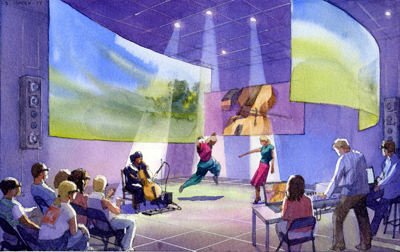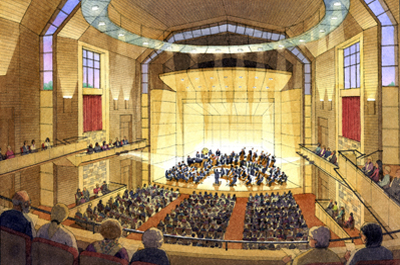|
Initiative for the arts in the works
by Albert Raboteau
Across the nation, such universities as Princeton, Stanford, Yale, and the University of Virginia are investing in their arts programs--and Virginia Tech is no exception. The university is working on an $82.2 million Arts Initiative that will not only bring new educational opportunities to students but also have a resounding impact by helping to attract outstanding students and faculty to Tech and by bolstering the local economy.
The Arts Initiative also will bring dramatic changes to the face of campus by creating a complex of new and renovated buildings on the upper quad just north of the Alumni Mall. The complex, called the Center for the Arts, is to include a renovated Shultz Hall, a visual arts gallery, and a performance hall able to seat 1,300. Construction is expected to begin in 2010 and take about two years.
|
|
The Campaign for Virginia Tech: Invent the Future seeks to raise more than $32 million in private contributions toward the Arts Initiative, which will also be funded by the university and the commonwealth. Private support is crucial to the project, according to Senior Fellow for Research Development Minnis Ridenour, who chairs the Arts Initiative Steering Committee.
"The superior quality of the performance facility and the advanced technology embedded in the teaching, laboratory, and production spaces can be accomplished though the generous support of donors," Ridenour says. "Philanthropy is right at the heart of achieving the vision of having an arts facility that allows you not only to experience art in the traditional fashion, but to use it in ways that benefit learning."
Along with facilitating construction, donor support will allow the university to hire an endowed faculty chair in the arts and to provide an infrastructure to meet future needs for learning and the creative process. For example, part of the space inside the Center for the Arts is earmarked for a creative technologies laboratory, where dynamic new methods of teaching by using technology will be developed and made available to instructors. The School of Education is already working with Southwest Virginia school districts to ensure that such techniques will benefit students beyond the Virginia Tech campus.
"We have an advisory group of about a half dozen superintendents who are saying, 'Just sign me up. Let's get this started,'" says Sue Magliaro, director of the School of Education and associate dean of professional education.
|
 |
|
|
conceptual renderings
|
Overall, university officials believe that the Arts Initiative will improve Virginia Tech's reputation, echoing the sentiments of former Virginia Tech presidents who recognized early on that the arts are an important part of a comprehensive university. When he became president, Charles W. Steger endorsed these goals and committed to increasing the presence of the arts on campus, noting, "The study of the arts is compelling because it enables us to sort and select, to analyze and interpret sense data that structure experiences in ways that educate us as rational thinkers and moral actors."
Mark McNamee, the university's senior vice president and provost, is another advocate for the Arts Initiative. "The arts are an essential part of the academic program at Virginia Tech," McNamee says. "The students who major in the arts benefit from the scholarship and talent of our faculty. The arts contribute to the education of many students in other majors as well. They engage and inspire students. This initiative will bring more than new buildings, and its impact will go beyond our fine arts departments."
In a recent analysis, a consulting firm, the Art & Science Group, found a 44 percent increase during the past decade in the number of SAT-takers interested in pursuing the visual or performing arts. Cultural venues are one of the amenities that make an institution attractive to the most highly sought-after students and faculty, regardless of discipline.
Strong cultural opportunities "could be the icing on the cake in a famous, international professor's decision to live [in Blacksburg] instead of Chicago," says Bobby Freeman (accounting '75; M.S. '77), a prominent real estate developer who is chairing a volunteer committee raising money for the Arts Initiative. Freeman, who incorporated monumental sculptures into the award-winning Port Warwick mixed-use development he brought to Newport News, Va., believes that an increased arts presence will trigger economic growth by making communities more attractive for tourists to visit and people to relocate.
|
 |
|
|
conceptual renderings
|
When realized, the Center for the Arts will bring together an interdisciplinary merger of the arts and technology, which will create greater opportunities for teaching and learning, strengthen the university community's creative potential, and enrich the entire spectrum of the arts.
"The project has a university-wide focus," Ridenour says, "but there is no question it can further serve as a magnet for community enhancement and economic development throughout the region. The potential for the center's impact is extraordinary."
Visit www.artsinitiative.vt.edu for more information.
 Albert Raboteau is a writer for University Development. Albert Raboteau is a writer for University Development.
|
|

A dozen years after her death, Margaret Rawlinson Svoboda (home economics '32) is still making a difference in the lives of countless youth, adults at Virginia Tech, and Extension programs. During her career with the Virginia Cooperative Extension Service and her professional and volunteer work with 4-H, Svoboda helped families and individuals find practical ways to overcome challenges and accomplish goals--and to share those skills with others.
The eldest of seven children, Svoboda was born in 1909 to a Wichita, Kan., minister and his schoolteacher wife. The family moved to Virginia, where Margaret attended Blackstone College and transferred to Virginia Polytechnic Institute (now Virginia Tech), earning her undergraduate degree.
After completing post-graduate work at Western Michigan University, Svoboda returned to Virginia Tech and 4-H, both of which she credited with providing practical, hands-on training that opened doors and fostered success. She had a gift for turning obstacles into opportunity and recalled being one of 64 female students at VPI. At the time, many male students resisted their presence, so the women created their own yearbook, The Tin Horn, and in 1933 formed their own alumnae society. Alumnae were later included in the Virginia Tech Alumni Association, and Svoboda was the first woman elected to its board of directors.
During the Great Depression, Svoboda began her career with the Extension service as a home demonstration agent, teaching practical household management. She remained committed to outreach programs for community, family, and youth, retiring in 1966 as VPI Cooperative Extension Service district supervisor.
One of the driving forces behind the 1966 creation of a 4-H camp at Smith Mountain Lake, Svoboda supported the facility--later named the W. E. Skelton Smith Mountain Lake 4-H Educational Center--during her career, after her retirement, and even after her death in 1996. The center's Svoboda Lodge is named in her honor.
In addition to endowments for extension and 4-H, Svoboda endowed the Frank C. Svoboda Virginia Tech Corps of Cadets Emerging Leader Scholarship in memory of her husband. Other gifts include support for graduate and undergraduate scholarships, excellence awards for Extension agents, and research-based community outreach programs teaching practical skills for managing family, finances, agriculture, the environment, and more.
To find a gift strategy that could accomplish so much, Svoboda consulted Virginia Tech's development office and her own advisors. She included Virginia Tech in her estate plans and used appreciated assets to fund charitable annuity trusts and a charitable gift annuity that paid her lifetime income, with the remainder funding endowments. Svoboda said she would use her gift annuity income "should a need arise." In practice, she regularly chose to use the payments to make additional gifts and enjoyed seeing their impact firsthand.
A tireless volunteer, Svoboda provided considerable lifetime financial support to the programs she valued. Her estate added more than $588,000 to that support, and her endowments will produce income in perpetuity. For generations to come, Margaret Svoboda's generosity will continue to invent the future.
To learn how you can create an estate gift or a gift that pays you an income, or to learn about other ways to give, call the Office of Gift Planning at 800/533-1144, e-mail giftplanning@vt.edu, or visit www.givingto.vt.edu.
 Judith Davis is publications editor for the Office of Gift Planning. Judith Davis is publications editor for the Office of Gift Planning.
|
|

